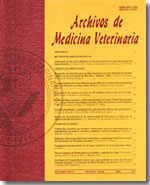Post-surgical abdominal adhesions in horses: pathophysiology, prevention and treatment
Main Article Content
Abstract
Despite the great number of human and veterinary medicine research, abdominal adhesions are still a big concern and a frequent complication for surgeons. The development of abdominal adhesions is a complex and dynamic process that involves a series of different mechanisms that start with an inflammatory process and tissue damage, followed by a fibrinogenic and fibrinolytic unbalance and ends with a change from fibrin deposit to fibrous tissue. In horses, after small intestine surgeries, adhesion incidence ranges from 14 to 22%. It is the most frequent cause of recurrent abdominal pain and the second cause for repeat celiotomy. Nevertheless, when all equine abdominal surgeries are included, the incidence of postoperative adhesions approximates 5%. A better understanding of the cellular mechanisms of adhesion formation and reformation should help to develop better prevention methods. Currently, a variety of prevention measures and treatments, most of them aiming to reduce or avoid adhesions formation, are used in veterinary medicine. The aim of this review is to gather most of the available information and the latest research explaining the pathophysiology, prevention and treatment of abdominal adhesions in horses.

